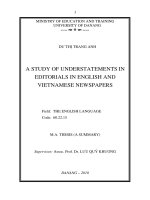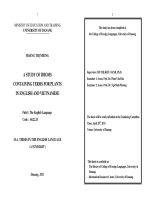- Trang chủ >>
- Khoa Học Tự Nhiên >>
- Vật lý
study of wo3-based sensing materials for nh3 and no detection
Bạn đang xem bản rút gọn của tài liệu. Xem và tải ngay bản đầy đủ của tài liệu tại đây (434.2 KB, 3 trang )
Ž.
Sensors and Actuators B 66 2000 74–76
www.elsevier.nlrlocatersensorb
Study of WO -based sensing materials for NH and NO detection
33
Xusheng Wang
a,)
, Norio Miura
b
, Noboru Yamazoe
b
a
Department of Technical Physics, Xidian UniÕersity, Xi’an 710071, People’s Republic of China
b
Department of Materials Science and Technology, Graduate School of Engineering Sciences, Kyushu UniÕersity, Kasuga, Fukuoka 816, Japan
Received 30 July 1998; received in revised form 28 January 1999; accepted 11 May 1999
Abstract
Gas sensing materials of WO loaded with 1 wt.% metal oxides were prepared and applied for NH and NO detection. The
3 3
measurement of NH and NO sensing properties of the materials revealed that WO q1 wt.% Mg, WO q 1 wt.% Zn, WO q 1 wt.%
3 333
Mo and WO q1 wt.% Re characterized good responses to NH and NO. As a whole, these materials have low resistance, high
33
sensitivity and fast response to NH and NO compared with pure WO . The possibility of NH –NO equivalent point sensor was
333
discussed. It can be used for real time monitoring, and controlling the reduction of NO using NH . q 2000 Elsevier Science S.A. All
3
rights reserved.
Keywords: NH and NO gas sensors; WO ; Metal oxides; NH –NO equivalent point sensor
333
1. Introduction
The release of various chemical pollutants from indus-
tries, automobiles and homes into the atmosphere has been
causing global environmental issues. Intense efforts are
being exerted on research and development of new tech-
nologies andror new chemical processes that can elimi-
nate or reduce air pollutants. The typical example is the
wx
reduction of NO by some selective catalysts with NH 1 .
3
But, the NO emitted varies with time and position, and
NH is also one of pollutants. In the reduction of NO
3
using NH , it is very important to control the amount of
3
NH to be used. The monitoring of NO–NH reaction is
33
eagerly awaited in environmental pollution control. Gas
sensors make it possible to detect air pollutants in real time
and can be used for feedback control systems of various
chemical processes. Compactness and low cost will also be
advantageous, not only for application to mobile facilities
wx
but also for multi-site monitoring 2 . WO -based semicon-
3
ducting gas sensors have showed good responses, both to
wx
NH and NO 3,4 , and characterized the opposite resis-
3
tance changes to them, which makes it possible to detect
the NH or NO, and the surplus NO or NH after the
33
NO–NH reaction. In this paper, the sensing materials of
3
WO loaded with 1 wt.% metal oxides were prepared and
3
characterized for NH and NO detection.
3
)
Corresponding author. Tel.: q86-29-8202560; fax: q86-29-5262281.
2. Experimental
Aqueous soakage method was used for preparing the
sensing materials. The WO powder was prepared by
3
ŽŽ .
pyrolyzing ammonium paratungstate NH W O P
410 12 41
.
5H O at 6008C for 2 h in air, and the doped materials
2
were nitrate or acetate. The sensing materials of WO
3
loaded with 1 wt.% metal oxides were prepared by solving
the doped original materials in de-ionized water at 60–
808C, adding the WO powder into the solution, stirring
3
and heating until it dried, then calcining at 6008C for 2 h.
The sensor element was prepared by applying WO -based
3
powder on an aluminum tube fitted with Pt wire elec-
trodes, and calcined at 6008C for 1 h. The NH and NO
3
sensing properties of WO -based materials were measured
3
Ž
in a conventional flow apparatus the gas flow rate was
3
.
fixed to 100 cm rmin in 3508C. The sensitivities were
defined as Ss R rR and Ss R rR , respectively, for
ag ga
NH and NO, where R and R were resistances of
3ag
sensing element in air and in sample gas.
3. Results and discussion
Fig. 1 shows the sensitivity of WO loaded with 1 wt.%
3
Ž.
metal oxides except noble metals responding to 30-ppm
Ž
NH and 40-ppm NO at 3508C for the sake of high
3
sensitivity and fast response both to NH and NO, this
3
0925-4005r00r$ - see front matter q 2000 Elsevier Science S.A. All rights reserved.
Ž.
PII: S0925-4005 99 00410-4
()
X. Wang et al.rSensors and Actuators B 66 2000 74–76 75
Fig. 1. Sensitivity of WO and WO q1 wt.% metal oxides to NH and NO at 3508C.
33 3
.
working temperature is suitable . For comparison, the re-
sult of pure WO was also shown. From the result it can
3
be seen that: the sensitivity and responding properties of
WO decayed with loading of alkali metals. The respond-
3
ing and recovery properties were obviously improved by
loading with alkali earth metals. The materials of WO
3
loaded with 1 wt.% Mg, Zn, Mo and Re showed good
responses both to NH and NO, and can be used for NH
33
and NO gas sensors. As a whole, these materials have low
Ž
5
resistance about 5= 10 V, Mg-loaded material was
.Ž
slightly higher , high sensitivity pure WO : Ss 5.40 for
3
30-ppm NH and Ss4.00 for 40-ppm NO; WO q1
33
wt.% Mg, Zn, Mo and Re: Ss7.65, 5.06, 10.1, 9.46,
respectively, for 30 ppm NH , and Ss5.87, 8.33, 5.00,
3
.
6.25, respectively, for 40 ppm NO , and fast response to
NH and NO compared with pure WO . The materials of
33
WO loaded with 1 wt.% Cr, La, Pr, Sm, Gd, Er, Tm and
3
Yb showed good responses to NH , and hardly responded
3
to NO, and the materials of WO loaded with 1 wt.% Ba,
3
Te, and Pb showed good responses to NO and hardly
responded to NH . These two kinds of materials can be
3
used as NH and NO selective gas sensors, respectively.
3
The characteristics of WO -based semiconducting mate-
3
rials responding to NH and NO, i.e., the opposite resis-
3
tance changes to NH and NO, respectively, make it
3
possible to detect the surplus NO or NH after the NO–
3
NH reaction. Fig. 2 shows the transient responses of a
3
WO sensing element to NO mixed with NH . From the
33
measurement, it can be seen that the NH –NO equivalent
3
point can be defined as the value of NH –NO, while the
3
sensitivity Ss1 in NO–NH mixture. It is necessary for
3
the existence of the NH –NO equivalent point that NH
33
and NO must be reacted completely. The NH –NO equiv-
3
alent point sensor was designed as follows: the sensor is
two-layer-structured, i.e., a catalyst layer was coated on
the surface of the WO -based sensing element. Two kinds
3
of NO reduction catalysts of TiO q10 wt.% CuOq5
2
wt.% SiO and TiO q8 wt.% V O q1 wt.% WO q5
22 25 3
wt.% SiO were used for the coating layers, and measured
2
for various NO and NH concentrations. Expedient results
3
were obtained.
Fig. 2. Transient response of WO to NH mixed with NO.
33
()
X. Wang et al.rSensors and Actuators B 66 2000 74–7676
4. Conclusions
The sensing materials of WO loaded with 1 wt.%
3
metal oxides were prepared and applied for NH and NO
3
detection, and several composition materials with good
responses, both to NH and NO, were obtained. The
3
designed NH –NO equivalent point sensor includes two
3
parts: one is a sensing material and the other is a catalyst.
This research gives a number of good candidates in semi-
conducting sensing materials for NH and NO detection.
3
The NH rNO equivalent point sensor can be used for real
3
time monitoring and controlling the reduction of NO by
NH , though further studies should be fulfilled.
3
References
wx
1 I.E. Wachs, G. Deo, B.M. Weckhuysen, A. Andreini, M.A. Vuurman,
Ž.
M. de Boer, M.D. Amiridis, J. Catal. 161 1996 211–221.
wx Ž.
2 N. Yamazoe, N. Miura, Sensors and Actuators B 20 1994 95–102.
wx Ž.
3 M. Akiyama, J. Tamaki, N. Miura, N. Yamazoe, Chem. Lett. 1991
1611–1614.
wx Ž.
4 T. Maekawa, J. Tamaki, N. Miura, N. Yamazoe, Chem. Lett. 1992
639–643.









